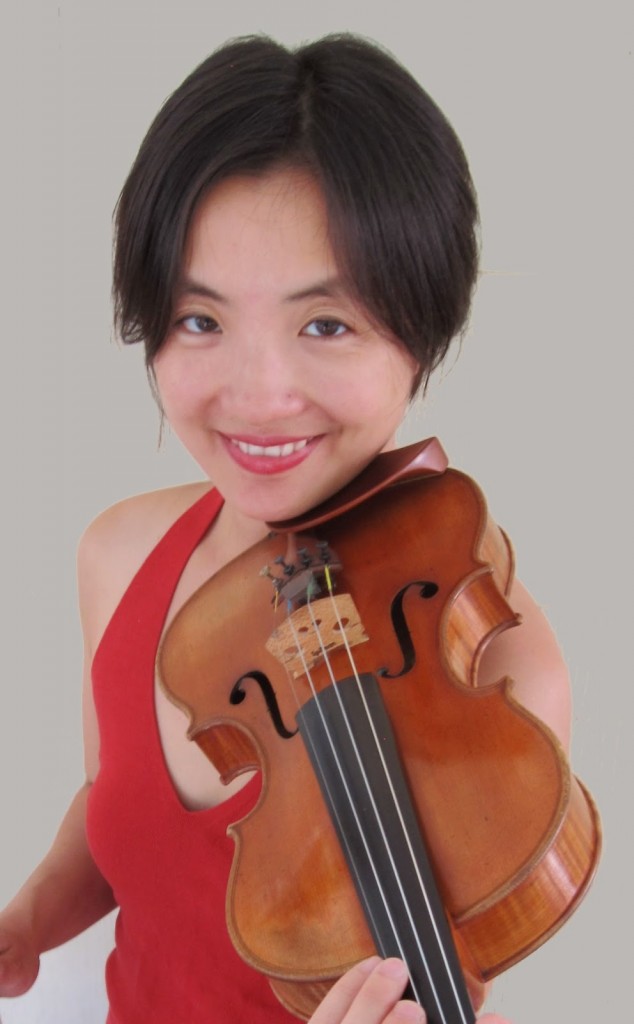Liu premiere proves a moving highlight of Lorelei Ensemble program

Shaw Pong Liu’s “Peace is a Woman in a House” received its world premiere by the Lorelei Ensemble Friday night at Marsh Chapel.
Comb the pages of musical history and you will uncover a number of works that were inspired by the visual arts. But one rarely encounters the opposite—freshly created art works that capture the shape, flow, and impact of a musical line.
Concertgoers were given the chance to see such a process unfold in real time at Marsh Chapel Friday night when the Lorelei Ensemble, directed by Beth Willer, offered the world premiere of a new work that involved a live calligrapher.
Shaw Pong Liu’s Peace is a Woman in a House grew out of a public art project last summer when passersby in Boston’s Chinatown created their own symbols for peace from basic Chinese characters. Material for some of the work, a Lorelei commission, derived from these sessions as well as the relationships between Chinese calligraphy and the intricacies of musical sound and rhythm.
The first movement of Liu’s piece features the singers in recitation of texts taken from interviews from the public art project. Calligraphist Mike Mei drew shapely Chinese symbols on blank canvases stretched across the front of the chapel while the singers mimicked his movements by moving their arms in brush-like strokes.
Liu’s music is hypnotically simple, featuring vocalizations that consist of rhythmic pops and hisses. These sounds break into small melodic fragments, and at the movement’s climax, multiple musical lines, each with its own text, weave into a sheet of sound.
The women of the Lorelei Ensemble sang with a pristine vocal blend, purity of tone, and smoothly tender phrasing. Yet this is no ordinary choir, and the singers made theatrical use of the chapel space.
This aspect of their performance seemed to be baked into Liu’s piece, especially in the third movement, where the singers slowly walked about the front of the chapel and down the side aisles, all the while chanting phrases that came to rest on icy dissonances. When the ensemble finally gathered center stage, they intoned eerie, siren-like chords. The effect was mesmerizing.
But the most affecting moments of Peace is a Woman in a House came in its second movement. Here, the singers were seated in the front of the church like children, humming soft harmonies with hands covering their mouths. Overhead, soprano Margot Rood floated soft, penetrating lines that told a heartbreaking story, based on the composer’s own experience, of domestic violence. A father, in a rage, savagely beats his wife. The children are unable to do anything except scream, “Daddy, please
stop.”
Liu’s music reflects the story in pulsing, almost sobbing phrases that escalate into a series of high wails. The composer herself was on hand to echo these passages on the violin, as if a memory.
Peace is a Woman in a House is an engaging and moving work that draws attention to serious issues without being preachy. One hopes it will receive many performances beyond Friday’s premiere.
The other new work that premiered Friday night was Carson Cooman’s The Dawning Light. Based on English translations of Eskimo texts, the seven movements of this work reflect, in music, the play of natural light and the rapture of prayer.
Cooman’s music is impeccably crafted, memorable, and makes colorful use of the Lorelei voices for which it was written. The wordless outer movements are the piece’s focal points, between which the composer traces a musical trajectory from darkness to light.
In all, the Lorelei Ensemble sang with clarity and shimmering blend to make a strong case for Cooman’s work. Conductor Willer, with gentle waving gestures, mined the nocturnal glow from the opening, the folk-inflected melodies of “Magic Prayer,” the slow, breathy phrases of “The Great Sighing,” and the bright rhythmic groove of “Song of Joy.”
The solo passages were sung with exceptional skill, with Emily Marvosh’s voice bringing a dark touch to the third movement, and Sonja DuToit Tengblad’s ringing soprano floating a sunlit melody in the fifth.
One feature that makes Lorelei Ensemble concerts so enriching is the combination of new and older music. Rounding out Friday’s program were selections from the two Medieval manuscript sources noted for florid polyphony.
A little over a hundred years separate The Las Huelgas Codex from Codex Calixtinus, and both feature works scored for two and three vocal parts.
The styles of each are remarkably different. The two works from Calixtinus, the older of the two sources, unfolded in free-moving, chant-like phrases, which the singers of Lorelei shaped with tender care. Many of the selections from Las Huelgas moved with dance-like energy, with the singers rendering the music with the triplet-feel style associated with the Notre Dame School.
But the most moving of these selections was O monialis concio, a lament sung without words that spotlighted Clare McNamara in soft, silky phrases. The singers of Lorelei joined in one
at a time, and when the full ensemble came together, the sound was resplendent.
The program will be repeated 8 p.m. Saturday at the Lowell Lecture Hall at Harvard University. loreleiensemble.com
Posted in Performances



